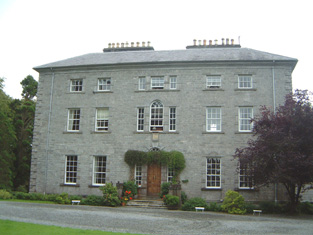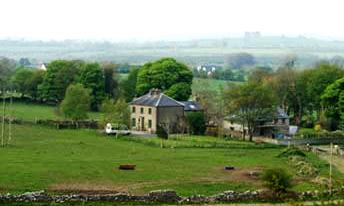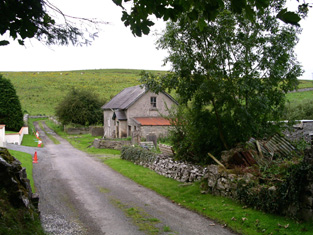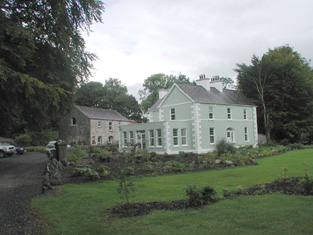Derroon House
Houses within 10km of this house
Displaying 46 houses.
Houses within 10km of Derroon House
Displaying 46 houses.
| House name | Description | |
|---|---|---|
| Mount Irvine or Mount Irwin | At the time of Griffith's Valuation Edward B. Thornhill held over 300 acres including the townland of Mount Irvine and a property described as offices, valued at £3. Lewis had recorded Mount Irvine as the seat of William T. Sherlock in 1837. This house is more usually known as Mount Irwin and was a seat of the Irwin family in the eighteenth century. It passed by marriage to the Thompsons and then to William Theophilus Sherlock. It was later sold in the Encumbered Estates Court and the Thornhills continued to own it until 1907 when it was sold to the Land Commission. Nothing remains of the original house. | |
| Flower Hill | Flower Hill was being leased by Magdalene Irwin from the Perceval estate at the time of Griffith's Valuation when it was valued at £3. The Irwins had a modest house at this location and in the 1820s set about building a larger property. Due to debt and court proceedings it was never finished and remains a roofless ruin. | |
| Roadstown | At the time of Griffith's Valuation Charles O'Connor was leasing the property at Roadstown, barony of Corran from Rev. William Hearne and Capt. Starke, when it was valued at £6.Lewis also records it as the seat of the O'Connor family. In the eighteenth century Roadstown was associated with the Fleming family some of whom are buried in the churchyard of Emlaghfad, near Ballymote. Roadstown House is still standing but derelict. The house and farm were sold in 2005. |

|
| Old Rock | At the time of Griffith's Valuation John Trumble was leasing a property valued at £4 at Old Rock, barony of Corran, from Johnston Parke. McTernan states that John Trumble eventually disposed of his interest in this property and settled in Manchester. The original house is no longer extant. | |
| Temple House | The Temple House estate extended into the Civil parishes of Cloonoghill and Emlaghfad as well as in the parish of Kilvarnet where the house is located. In 1786 Wilson refer to Temple-house as the seat of Mr. Perceval. The present house was built c.1820 but was subsequently modified. In 1894 the house was noted by Slater as the seat of Mrs. Perceval. Remains of earlier Perceval houses are to be seen in the demesne. |

|
| Greyfort | Alexander Perceval was the lessor of a property valued at almost £6 at Lislea, barony of Corran, which he was leasing to James Dale at the time of Griffith's Valuation. McTernan notes the house as the seat of the Rea family from the mid-seventeenth to the mid-nineteenth centuries. A number of other families occupied the house up until the 1980s when it was demolished. | |
| Abbeyville | Abbeyville was originally a Phibbs property. McTernan states that it was leased to William Fleming after the death of William Phibbs in 1785.The original house was built in 1716 but extensively modernised afterwards. In 1814 it was the residence of William Fleming. At the time of Griffith's Valuation it was being leased by James Fleming from William Phibbs and was valued at £6. In the later nineteenth century it passed out of the Fleming family. It was demolished in the later twentieth century. Leet indicates that Archibald Fleming resided at Larkfield, also close to Ballymote. | |
| Drimrane | At the time of Griffith's Valuation John Taaffe was leasing a property at Drimraine, barony of Corran, valued at £6 to John Davis. It was in use as a herd's house accompanying a holding of over 100 acres. McTernan states that Davies subsequently sold the property to the Reynolds family in whose possession it still remains. | |
| Cloonshanbally | Margaret and Henry Gorman were leasing a property valued at £12 at Cloonshanbally, barony of Tirerrill, from the Gore Booth estate at the time of Griffith's Valuation. | |
| Earlsfield | Earlsfield had earlier been a Dodwell property. At the time of Griffith's Valuation it was leased from the Gore-Booth estate by Capt. Richard Gethin and was valued at £20. Slater records it as the seat of Francis Gethin in 1894. It is still extant and has served as a convent for many years. |

|
| Carrowkeel | At the time of Griffith's Valuation John F. MacDonagh held property valued at £12 at Carrowkeel, barony of Corran, from the Gore Booth estate. Lewis also records this as a MacDonagh property, describing it as a "fine modern residence". McTernan notes that Carrowkeel was probably built by Francis MacDonagh at the beginning of the nineteenth century. It remained in the family until its sale in the Landed Estates Court. It is still extant and occupied. | |
| Newpark | At the time of Griffith's Valuation Newpark was being leased by Jemmet Duke from Robert Duke and was valued at £25. Lewis recorded it as the seat of Robert Duke in 1837. McTernan notes that it passed by sale to Richard Edward O'Hara of the Annaghmore family in 1913. The house is still extant and occupied by his descendents. |

|
| Battlefield | McTernan notes that Battlefield was built for the Knott family in the early nineteenth century. At the time of Griffith's Valuation James Knott occupied the property, then valued at £20. Both Leet in 1814 and Lewis in 1837 record Battlefield as a residence of the Knott family. In the later nineteenth century the house passed into the ownership of the Robinson family, descendents of the Knotts. with whom it remained until the 1940s. It was sold and subsequently demolished. | |
| Kilturra | At the time of Griffith's Valuation Joseph Verscoyle was leasing a property valued at £6 together with over 300 acres to Bartholomew McGettrick, at Kilturra, barony of Corran. This later became the residence of John Ormsby Cooke. It was partially damaged by fire in 1920 and Cooke eventually abandoned the property which became derelict. It was demolished in the 1930s. | |
| Clooncunny | At the time of Griffith's Valuation Thomas Rice was leasing a property valued at £5 together with over 150 acres at Clooncunny, barony of Leyny, from the Kirkwood estate. Lewis records Thomas Rice's seat as Achonry in 1837. A house and farm are still extant at this location. | |
| Annaghmore (Nymphsfield) | Annaghmore has been the principal seat of the O'Haras since medieval times. An earlier house on the site had been demolished by 1684. It's successor was replaced by the present house c.1820. That house was known in the eighteenth and early nineteenth century as Nymphsfield and is described by McParlan in 1802. In 1786 Wilson refers to Nymphsfield as the pleasant seat of Mr. O'Hara. The name of the house was changed back from Nymphsfield to Annaghmore in the early 19th century and the house was further enlarged. In 1894 it was the seat of Capt. Charles K. O'Hara. In 1906 the house was valued at £68. Annaghmore is still extant and occupied by the O'Hara family. |

|
| Markree Castle | Markree Castle was built in the early nineteenth century replacing an earlier property, which McParlan indicates was known as Mercury. McTernan notes that it is the oldest residential site in the county, having been founded by Cornet Cooper in the seventeenth century. At the time of Griffith's Valuation it was owned by Edward J. Cooper and was valued at £90. By the mid twentieth century it had fallen into disrepair but was later acquired by another member of the Cooper family. It now operates as a hotel. See http://www.markreecastle.ie/history.htm for more information. In 2014 it was offered for sale. |

|
| Cloonamahon | In 1854 when the estate was offered for sale by Thomas James Meredith the house was described as "a good slated dwelling-house..somewhat out of repair, but with a little outlay, it could be made very comfortable". In 1906 Dr. Henry Tweedy was the owner of buildings valued at £50 at the site. Following the departure of the Tweedy family the property was used as a sanitorium and later a retreat centre. McTernan notes that the original house was demolished in 1976 and replaced by modern buildings. Most of the site is now occupied by a Health Service facility. | |
| Lisconny | Lisconny was a property which belonged to the Phibbs family in the eighteenth century. McTernan notes that it had been purchased by them from the Mortimer family in the 1770s. It passed to the Toler family, earls of Norbury, through marriage. At the time of Griffith's Valuation, it was occupied by Bernard Owen Cogan, leasing from Lady Norbury's estate. It was then valued at £20. Lewis also records it as being occupied by the Cogan family in 1837. Johnston asserts that the Cogans acted as agents for Lady Norbury's estate in Ireland. The house was demolished early in the twentieth century. Very few traces remain except some walls of the stable yard and a building which had been an annex to the big house. | |
| Coopershill | Coopershill House was completed in 1774. McParlan described its situation as delightful in 1802. Lewis records it as the seat of Arthur Cooper in 1837. At the time of Griffith's Valuation it was occupied by Charles William Cooper and valued at £52. Charles William Cooper later succeeded his uncle as owner of the O'Hara of Annaghmore estate and henceforth Coopershill bacame an O'Hara property. He is recorded as the owner in 1894. The house is still extant and run as a guesthouse by the O'Hara family. |

|
| Spotfield | Spotfield appears to have been the property of the Phibbs family in the 19th century but in the 18th century may have been occupied by the White family who had intermarried with the Phibbs. At the time of Griffith's Valuation, it was leased by John Phibbs to Eccles Phibbs. The house was then valued at almost £4. McTernan notes that the house was demolished in the latter part of the twentieth century. | |
| Heathfield (Sligo) | The house at this site was built c.1890 presumably replacing an earlier house listed in Griffith's Valuation, when it was being leased by William Phibbs from the Cooper of Markree estate. At that time it was valued at £6. In 1906 it was owned by Thomas Randle Phibbs and was valued at £22. This later house survives and has been offered for sale in recent years. Ruins of gatelodge and gated entrance visible at G656219. |

|
| Tanzyfort | Tanzyfort House was built by the Cooper family in the mid-17th century and occupied by them until the completion of Coopershill House in 1774. Wilson, however, still refers to it as the seat of Arthur Cooper in 1786. Orser provides a detailed description of the layout of Tanzyfort House. | |
| Mount Dodwell | Henry Crichton was the owner of a property valued at almost £7 at Ballinvoher, barony of Corran, in 1906. This may be the cottage which is still extant and was possibly a steward's house. At the time of Griffith's Valuation, it was being leased by Samuel Gilmore from the Creighton estate and was valued at £5. Lewis records Mount Dodwell as the residence of Charles Thompson, who was related to the Dodwell family. This was the original house, which had stood here since the eighteenth century. It ceased to be a residence in the mid-nineteenth century and was subsequently demolished. |

|
| Toberscanavan House | At the time of Griffith's Valuation, James Noble was leasing this property, valued at £3 from the Cooper estate. McTernan notes that it remained in the Noble family until the later twentieth century. It is still extant but derelict. |

|
| Kingston Lodge | Johnston states that Kingston Lodge was a residence of the McLoghry family. McTernan notes that it is a mid to late nineteenth century building, built by Henry McCloghry, son of Thomas McClogry of Carrickcoola. It was being leased by him from the Cooper estate at the time of Griffith's Valuation and valued at almost £4. The house remained in the McCloghry family until the 1940s and is now in a derelict state. | |
| Ardagh | At the time of Griffith's Valuation Richard Graves Brinkley held extensive property at Ardagh and Bellanascarva, barony of Tirerrill. This had formerly been part of his wife, Hester Lloyd's estate. Ardagh House was then valued at £14. Johnston states that the property at Ardagh was later lived in by Hunter family who acted as agents for the Brinkley estate. Part of the extensive farmyard of Ardagh House has been converted into residential accommodation. An extensive mill complex in the nearby townland of Bellanascarva was leased to Munds Harper at the same time where Brinkley also held a house valued at £30. |

|
| Lissycoyne | At the time of Griffith's Valuation, Patrick McDermott was leasing a property valued at £7 at Lissycoyne, barony of Tirerrill, from the Brinkley estate. It is shown as diminished in size on the 25-inch Ordnance Survey map of the 1890s. Some farm buildings are located at the site now. | |
| Bellamont House | Archaeological research would appear to indicate that Richard Coote had a fortified house at Collooney sometimes referred to as Bellamont House or Collooney Castle. A later structure in the town, also known as Bellamont House, is not associated with the Coote family. A possible site for Collooney Castle has been identified by Timoney drawing on earlier sources such as Terence O'Rorke. | |
| Atteville | Both Leet and Lewis indicate that Atteville was the seat of the Knott family with William residing there in 1814. At the time of Griffith's Valuation the property was in the possession of William Phibbs. It is described as a "herd's house" and was valued at almost £2. | |
| Branchfield (Duke) | At the time of Griffith's Valuation Alexander Duke was leasing property valued at £8 with almost 300 acres, at Branchfield, barony of Corran, from Jemmet Duke. Lewis records Branchfield as the seat of Rev. William Duke in 1837. Wilson notes Branchfield as the seat of Mr. Duke in 1786, remarking that the ruins of Coolteem Castle are nearby. Branchfield House has been offered for sale in recent times. |

|
| Kilcreevin | Lewis records Kilcreevin as a seat of Jemmett Duke in 1837. Griffith's Valuation shows that Jemmett Duke was leasing over 250 acres from the Coopers of Markree in this townland including a property valued at £2. |

|
| Kilmorgan | Jemmet Duke held 220 acres at Kilmorgan, barony of Corran as well as a property valued at £5 at the time of Griffith's Valuation. Lewis had recorded Kilmorgan as the seat of Robert Weir. McTernan notes that Kilmorgan had belonged to the Trumble family but was sold by them in 1855. The site is now occupied by farm buildings. | |
| Knockalass House | At the time of Griffith's Valuation, Patrick Graham was leasing a house at Knockalass, barony of Corran, valued at £5 together with 75 acres from the Gore Booth estate. McTernan notes that the Grahams were initially tenants and later owners in fee. |

|
| Brick Field | At the time of Griffith's Valuation William Phibbs held a property valued at £6 at Knockbrack, barony of Corran. In 1906 this property was valued at £11. | |
| Markree Observatory | E.J. Cooper was a well-known astronomer and observer of weather patterns. He had this observatory built at Markree c. 1850. It was valued at £40 at the time of Griffith's Valuation. Though now derelict it contains some original features. The archival collection of weather observations taken at Markree is now held by the library of Met Eireann, the Irish meteorological service. |

|
| Keenaghan Mill | At the time of Griffith's Valuation John and Henry Gorman were leasing an extensive milling complex at Keenaghan, barony of Corran from Robert Gore Booth, then valued at £83. |

|
| Greenfield Cottage/Greenville | At the time of Griffith's Valuation, Henry Burrowes was leasing a property valued at almost £8 from the O'Hara estate at Coolaney. This seems to be the property marked on the 1st edition OS Map as Greenfield Cottage. It appears on the 25-inch Ordnance survey of the 1890s as Greenville. The original house is no longer extant. | |
| Somerton | Somerton House appears to have been the residence of the agent to the Perceval estate. At the time of Griffith's Valuation the latter estate was owned by R.W. Hall-Dare. Somerton was then occupied by Christopher L'Estrange and was valued at £14. It is still extant. |

|
| Greyfort Cottage | At the time of Griffith's Valuation, Nicholas Gardiner was leasing a herd's house valued at £4 and lands from the Nicholson estate. This property is labelled Greyfort Cottage on the 1st edition Ordnance Survey map but it is not shown on the later 25-inch edition of the 1890s. | |
| Achonry House | John Docker was leasing Achonry House from the Armstrong estate at the time of Griffith's Valuation, when it was valued at £8. McTernan states that local tradition suggests the house was built by Docker when he leased the property from the Armstrongs. It was subsequently occupied, until the 1930s, by the Gorman family. It is still extant and has recently been renovated. | |
| Cuiltybar | Occupied in the eighteenth and early nineteenth centuries by relatives of the O'Haras of Annaghmore. Leased in the 1830s to John Fenton Motherwell and afterwards his widow Elizabeth who held it at the time of Griffith's Valuation. It was then valued at £7 10s and leased to George Martin. It returned to members of the O'Hara family in the early twentieth century after which the land was acquried by the Land Commission. Still extant and occupied, McTernan notes that it is one of the oldest occupied houses in county Sligo and was, in the distant past, known as Trimgrove. | |
| Larkhill | A late nineteenth century house which replaced an earlier residence on an adjacent site. Held by the Greer family from the Perceval estate at the time of Griffith's Valuation, when the house was valued at £1. The property was later acquired by the Bell family who built the existing house. Purchased in the twentieth century by the Taylor family and still extant and occupied. | |
| Quarryfield | McTernan notes that Robert Howes of Bunninadden and Quarryfield married Jane Irwin of Mount Irwin in 1754. Subsequently the then house at Quarryfield alternated between Howes and Irwins. In the 1840s the property was purchased by Col.Perceval of Templehouse and later in the nineteenth century by the Coopers of Markree, by whom the present house was built in 1887. The house had a number of owners since and is still extant and occupied. |

|
| Thornhill (Ballinacarrow) | At the time of Griffith's Valuation, Charles Gilbert was leasing a house and bleach mill at Ballinacarrow North, from the Hall Dare (earlier and later the Perceval) Estate. The combined valuation of the buildings was over £21. McTernan states that this is Thornhill House and mills. The mills had ceased to operate in the early twentieth century but the house is still extant. | |
| Roshin Lodge | Francis Foster was occupying Roshin Lodge at the time of Griffith’s Valuation. It was leased from the Conyngham estate and valued at £18. Foster's daughter, Mary Stewart Foster, married John Stouppe Charley of Belfast. She sold the property after his death. In 1876 it was offered for sale by Arthur Sandys Forster. Roshin Lodge was described as 'a spacious dwelling house, comprising 29 apartments' at that time. By 1901 it was the residence of William Smyth and his family. He had died by 1911 but his widow and children still occupied the property. |

